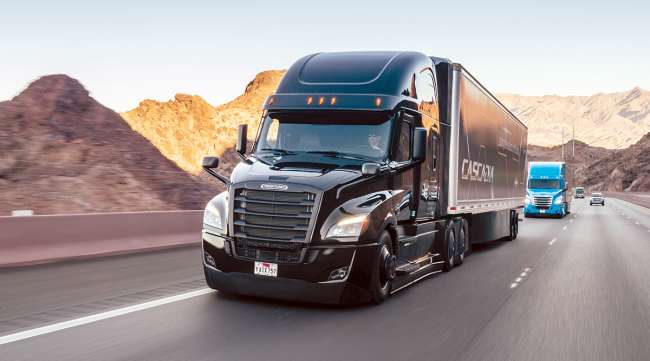Senior Reporter
Daimler Records Higher Net Income on Lower Revenue in Q3

[Stay on top of transportation news: Get TTNews in your inbox.]
Daimler AG reported higher net income on lower revenue in the third quarter as core markets began to recover from the impact earlier this year of the coronavirus pandemic.
Daimler, which reports in euros, saw net income for the period ended Sept. 30 increase to $2.5 billion, or $2.28 per diluted share, compared with $2.1 billion, or $1.91, a year earlier.
Revenue fell to $47.6 billion compared with $51.2 billion a year earlier.
The COVID-19 pandemic continued to affect severely the global economy, but Daimler said “a fairly dynamic recovery” began in May as restrictions were relaxed. That has continued in the third quarter — albeit “quite unevenly by region and sector.”

Wilhelm
The third quarter showed the company’s “very strong performance and is further proof we are on the right path to reduce the break-even point of our company,” Daimler Chief Financial Officer Harald Wilhelm said during an online presentation.
He added the faster-than-expected market recovery for its vehicles compared with the second quarter “gives us confidence to push ahead both the strategic and operational side of the business.”
In the quarter, Stuttgart, Germany-based Daimler saw global truck sales tumble 25% to 94,141 units compared with 125,382 in the same 2019 quarter.
In North America, truck sales fell 22% to 41,755 in the quarter compared with 53,240.
Overall truck revenue fell to $10.9 billion compared with $13.5 billion.

Home | Video | Heroes' Photo Gallery
Saluting the men and women of the trucking industry who kept America's essential goods flowing during the coronavirus pandemic.
Heroes: Peter Lacoste | Susan Dawson | James Rogers | Reggie Barrows | Kevin Cooper | Cesar Quintana Moreno
At the truck segment, “we are keeping a strong focus on cash preservation measures, strict cost control, and progressive execution of restructuring activities resulted in a noticeable reduction in fixed costs, as well,” he said.
The company noted major truck markets are expected to develop very unfavorably this year as a result of the economic crisis related to the coronavirus. It assumed Class 8 demand in the North American market will decrease significantly compared with a year earlier, but did not provide a specific forecast.
On a brighter note, Mercedes-Benz Vans posted third-quarter unit sales of 106,900 vehicles, up from 100,300 in the 2019 quarter. “With sales of 18,500 units in North America, we recorded our strongest-selling quarter so far,” the report said (with sales rising) compared with 14,100 a year earlier.
In the United States, Daimler sold 16,000 vans in the third quarter, up from 11,600 a year earlier.

Over the past few episodes, we've had the chance to listen to the experiences of industry leaders and the strategies and planning that go into finding the right people for your workforce. Host Michael Freeze reviews the most important bullet points, from technician and driver training to incorporating diversity in recruitment and retention. Hear a snippet, above, and get the full program by going to RoadSigns.TTNews.com.
Wilhelm said the quarter showed a “massive operational turnaround” in the van business, with profitability in the segment “very much in line with Mercedes-Benz cars.”
Mercedes-Benz Cars, Daimler’s largest business, sold 566,581 automobiles worldwide in the third quarter, down from 604,655 a year earlier. Those sales fell by 33% in North America, the most overall.
The earnings report emphasized Mercedes-Benz has set a new strategic course for profitable growth in the luxury segment and “aims for a leading position in electric drive and vehicle software.”
Quarterly highlights related to the truck segment included:
- Daimler Trucks presented its hydrogen-based, fuel cell concept truck, the GenH2 Truck, for the longhaul freight segment. Series production is planned to begin in the second half of the decade. It uses liquid instead of gaseous hydrogen, so its performance should be on par with that of a comparable conventional diesel truck, due to its significantly higher energy density, according to the company.
- Daimler Trucks provided the first preview of its Mercedes-Benz eActros purely battery-electric long-distance truck, with a range of about 310 miles (500 kilometers) on one battery charge.
Meanwhile, its research and development spending in the third quarter of the year amounted to $2.4 billion compared with $2.9 billion in the 2019 quarter.
More than three quarters, or $2.1 billion, of the research and development expenditure was at Mercedes-Benz Cars & Vans. The main areas of development expenditure were for the next generation of electric vehicles and battery production.
The most important projects at Daimler Trucks & Buses were in the areas of emission standards and fuel efficiency, as well as “tailored products and technologies for major growth markets” — including autonomous driving, electric mobility and connectivity.
At the end of the third quarter, the Daimler employed 291,770 people worldwide compared with 298,655 at the end of 2019.
Want more news? Listen to today's daily briefing:
Subscribe: Apple Podcasts | Spotify | Amazon Alexa | Google Assistant | More




